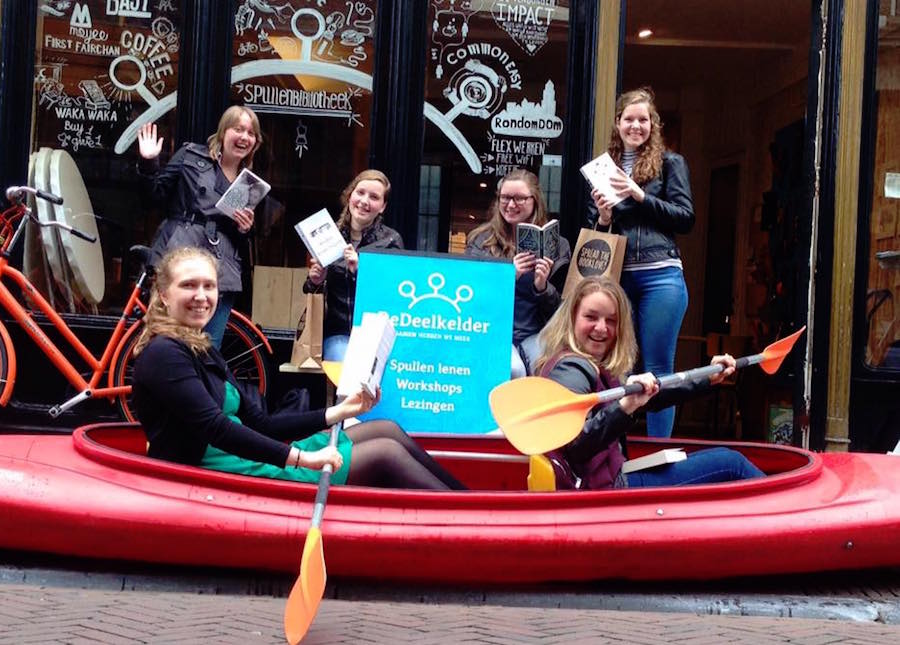Imagine going into a neighborhood shop to borrow tools, kitchen appliances, camping gear, party supplies, sports equipment, musical instruments, and more. You wouldn’t have to buy, repair or store infrequently used items. You’d have access to a much wider variety of goods than you could ever own, and you could easily share things with neighbors. This is the idea behind a Library of Things.
Shareable connected with Gene Homicki, co-founder and CEO of myTurn, an online platform that makes it easy for anyone to start and manage a Library of Things. Communities use myTurn to share tools and home goods, universities use it for bike and equipment lending, and utility companies use it to share energy efficiency tools with builders.
As Homicki says, myTurn allows new lending libraries to use the “best practices baked right into the platform” and focus on the things that are unique to their community. The platform is used by over 130 tool, kitchen, and other community lending libraries, as well as hundreds of nonprofits, universities, municipalities, and enterprises.
We asked Homicki for his top tips for starting a Library of Things.
Shareable: The Library of Things movement has grown from a whisper into a buzz. What’s behind the excitement? What’s the future for Libraries of Things?
Gene Homicki: More and more people are realizing the joy of being able to access the things they need, without the burden of owning and storing them. This movement, and the buzz behind it, really started with tool libraries and kitchen libraries, and other specialty lending libraries, most of which got their start using myTurn.
Now, Libraries of Things are rolling together all the things people only infrequently need and bringing them together in one place, so they have something for everyone. Pay one membership or subscription fee, and you can borrow everything from camping gear to a popcorn maker—how awesome is that?
And more than just access to stuff, Libraries of Things typically build community by offering classes and a place where people can share not just things, but also ideas and skills. The best Libraries of Things start out building a place to borrow and share things and end up building a community.

Once someone decides to create a Library of Things, what are the first steps to get started?
It’s really exciting when you first come up with or learn about, a library that lends tools, camping gear, games, and other things, rather than just books. As a first step, share that excitement with others and start to form a team to make the Library of Things a reality. Also, learn more about what’s already been done and the types of resources that are available to help you get started.
Reading posts about Libraries of Things on Shareable is a great start and there are other resources online including the ShareStarter.org site, as well as existing Libraries of Things to learn from. For example, SHARE – A Library of Things, in Frome, England, which was the first permanent library of things, offers a whole packet of information about how they got started and includes sample forms and procedures.
Don’t reinvent the wheel when you don’t have to. Talk with others who have done it already, then start defining the plan that is right for your community. Bringing others in early and learning what resources are available helps ensure you don’t feel too overwhelmed and, besides, it’s more fun to plan and work with others.
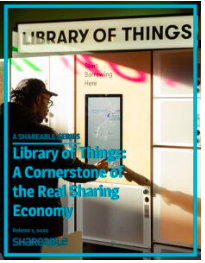 |
Download our free ebook: Library of Things: A Cornerstone of the Real Sharing Economy |
What kind of team do you need to get a Library of Things started? What are some valuable or necessary skills?
We typically recommend a core team of three to seven people so you’re not doing everything yourself, and you have a variety of skills on the team. Diverse backgrounds and skillsets are ideal, but not completely necessary.
Useful skills to have include project management, bookkeeping, and finance, fundraising, legal, marketing, design and technology. These are really similar skills needed to start any organization or business. I recommend mapping out the skills your team does have and find advisors to help you fill out the skills your team might be missing.
If you’re starting as a nonprofit, you can often find discounted or pro-bono legal and other professional services. In addition to finding local volunteers, nonprofits may also be able to tap into AmeriCorps volunteers.
As you prepare to open, team members with management (retail, volunteer management if you’re a nonprofit, etc.) skills, and also skills to maintain and repair the items in your Library of Things can be exceedingly useful.
Don’t let one or a few missing skillsets stop you from getting going. If you’re passionate about the idea and can communicate it well to others, you’ll almost certainly be able to inspire others to help you fill in the gaps.
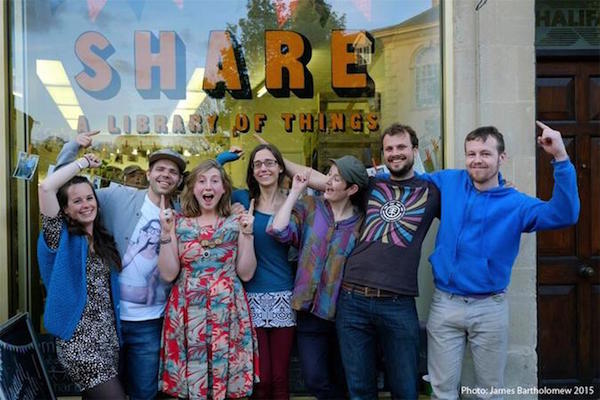
What options are there for organizational structure of a Library of Things? Nonprofit? For-profit? Cooperative? An offshoot of an existing organization or library?
We currently have over 130 libraries lending to the public on the myTurn platform, and all of those structures—co-op, nonprofit, for profit, public library and offshoot of an existing organization—are represented by our customers.
Many public libraries are looking for ways to stay relevant and increase the services they offer to their communities, therefore many of these institutions are receptive to the idea of expanding to lend out more types of items.
Personally, I like the co-op model, where community members have a direct stake in the success of the library. One of our first customers, the Vancouver Tool Library, manages both their co-op membership and their tool library membership via our platform.
Since Libraries of Things can help reduce consumption and waste, while providing access to items many people can’t afford to buy, going the nonprofit route can open up funding from local government, community foundations, and people who are willing to donate toward helping address these important social and environmental issues. With a non-profit or co-op model, people are often very open to donating their own underutilized items to help support what is clearly a community resource. This often makes it very easy to build your initial inventory.
At this point, the for-profit model offers the biggest risk—and reward. You typically don’t have the built-in customer base you get with a co-op (the co-op members) and accepting donations of items is not always an option. If you have the resources to go this route though, rental businesses have been successful and profitable for many decades, and this is an extension of that model into other types of items and services. In fact, we hope to see more “sharing centers” and fewer shopping centers in the future.
Do you need a business plan? A budget? What other things are necessary?
Whether you’re a nonprofit, for profit, co-op or other type of organization looking to start a public Library of Things, we do recommend at least putting together basic business plan. Rather than a 20-page formal business plan that almost no one will look at, we recommend using the Social Lean Canvas or one of the other business canvas templates that have come out of the lean business movement.
Whether you’re writing grants, starting a crowdfunding campaign, or talking with potential investors, you’ll also want to have a budget and basic financial projections. Again, cover the basics so you have a general idea of what you’ll need to start and manage the library, but you don’t need to have every piece in place before moving forward.

What types of items work best in a Library of Things? Are there things that don’t work well?
The best items for a Library of Things are those that people want and need, but might not have the space to store, the money to purchase, or the need to use all the time. You also want to stock items that are both durable and repairable, since they’ll see a lot more use than the typical power drill that is only used for 10 to 20 minutes over its life before being disposed of.
So far, we’re seeing all types of items like hand and power tools, baby carriers, board and video games, sporting goods, bread makers, drones, party supplies, camping gear, and just about anything else you can imagine. We strongly recommend doing market research in your community before you open to ensure the items you’re going to carry are the ones that are most appropriate for your area. At myTurn, we can provide advice on the most popular types of items in areas similar to your new Library of Things, and even ones that have proven to be more repairable and durable.
To get started, we recommend putting together—or borrowing from an existing Library—an initial wish list, then get feedback from potential members of the Library of Things to see what they want.
Good examples for a starter list include tools, like a tile saw or floor sander that you might only need for one project or that not everyone can afford. If you live in a food desert, or where there is food insecurity, gardening tools are a great option to help people grow their own food. Camping gear can be a great way to help introduce more people to the outdoors and nature. All sorts of kitchen tools like bread makers, ice cream and pasta makers or other items that most people find to be fun but don’t use every day are useful. Toys, board games, and especially pricey video games are also great items to have, as some parents can’t afford them and kids can get tired of them quickly. I would have loved to have access to hundreds of toys and games as a kid (and love it now!).
Things to avoid are items that are not durable or made to hold up to high usage. Libraries of Things should focus on trying to get more durable and repairable items that can be reused over and over. Other types of items to avoid can be ones that are dangerous (e.g. chainsaws), need a lot of maintenance or calibration between each use, or that need—and can be difficult—to clean between every use.
Again, it is really important that as you are planning your Library of Things that you survey your members and potential members to see what they would want and need—and create and post a wish list.

How does a Library of Things obtain its inventory? Do they purchase it or get it donated?
For nonprofits and co-ops, we recommend accepting donations of items from the community. If you’re getting started in the US, Canada or an area with a good mix of incomes and socioeconomic status, there are almost always some people who have too much stuff in their garages, closets, attics, and storage spaces that are happy to get items back into use.
Accepting donations also gives more people in the community a sense of ownership and accomplishment, because they’ve helped make the library of success. In turn, this sense of ownership helps reduce the number of items that are not returned or are returned late because not returning an item would be like stealing from your neighbor or even yourself.
There are some items that you just can’t get via donation. Things that are in high demand, or where the low-cost versions break down often, for example, pressure washers. For these types of items, we strongly suggest purchasing the most durable and repairable items you can afford. With the large number of organizations using our platform, at myTurn, we can even make recommendations on some of the best items to purchase for a lending library based on usage and durability statistics.
What kind of space works the best for a library of things, and what requirements are there of the space, in regards to infrastructure?
Similar to retail spaces, the best types of spaces for a Library of Things are those that are visible and easily accessible to the community. The Sharing Depot in Toronto recently moved from a basement space to ground-floor retail that allows people just walking down the block to see, and covet, the things they can borrow. Co-locating in community centers, public libraries, or even in schools or universities can provide a way to tap into existing foot traffic as well.
Libraries of Things can get really creative with their spaces though. For example, the Missoula Urban Development project runs a Tool and Kitchen Library out of multiple shipping containers, the London Library of Things also just opened in a reclaimed shipping container. DeDeelkelder in Utrect, Netherlands allows you to paddle right up to the Library of Things as they operate out of what used to be wharf storage space that has been converted into a community resource, and more recently, out of a pop-up shop.
I also recommend getting more space than you think you’ll need, though not more than you think you can afford, if possible. Almost every library we’ve helped get started has run out of space—especially the ones that accept donations of items from the community.
As the Library of Things movement gains steam, we’re going to see new spaces popping up that range from the rugged to the high-end retail. Imagine a traditional mom and pop rental shop with a gaggle of items everywhere, to spaces that look more like an Apple store or Tesla dealership that are ultra modern. What works best is going to depend on the target customer and location.
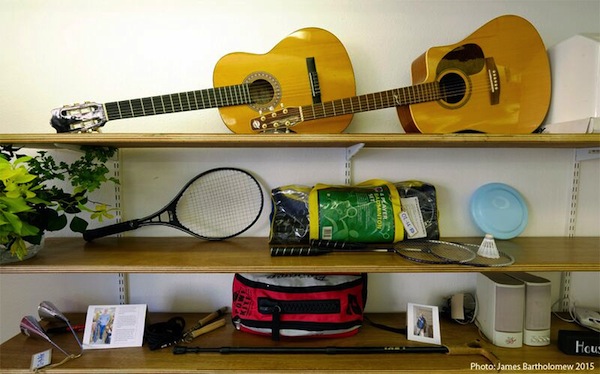
How do you suggest people find a space? Are there best practices in dealing with landlords or owners?
To an extent, this depends on the type of organization, budget, and where you are.
For small nonprofits and community groups, we recommend trying to find partner organizations that already have potentially underutilized space. Check with developers and landlords that are looking to support a more resilient community and might be willing to provide discounted or even free space. As an example, the Santa Rosa Tool Library operates out of extra storage space for a local architecture firm that supports their mission.
Also work with local government or building owners of vacant space. It’s easier to rent a vibrant space with foot traffic than an empty one, so this often works out as a win-win situation. The Library of Things get a pop-up space for a pilot, and the landlord ends up with a more valuable space.
If you’re in a low or mixed-income area and plan to ensure everyone can afford to use the Library of Things, see if there are programs that can help fund your space or receive other discounts.
If you’re operating your Library of Things as formal business, you’ll likely be going with a traditional lease. Laws and regulations vary from municipality to municipality, state to state and country to country and we typically recommend at least talking with a commercial real estate expert.
No matter the type of space or organization, we recommend having someone familiar with leases and contracts—preferably legal counsel—check over the lease before you sign it.
What kind of insurance options are there for a Library of Things?
A Library of Things looks a lot like either a library or a rental shop to insurers, so there tend to be different options depending on how you form your Library of Things.
In the US, we know a number of Library of Things that have had luck with Philadelphia Insurance as they often write policies for nonprofits and more unique businesses.
There are also newer insurance services that focus on the sharing economy and on-demand economy. These might be more appropriate if, and when, a Library of Things helps facilitate rentals or sharing directly between their members in a peer-to-peer fashion.
Many public libraries are self-insured through their municipality or can get an additional rider on their existing policy for their Library of Things if needed.
In addition to insurance, also be careful of other legal requirements. For example, there are data privacy requirements in Canada, Europe, and other locations that cover even basic contact information. At myTurn we help on the electronic side, but there are often data security and other procedures for how you handle user data locally that can still apply. We’re looking at these types of options and potentially offering insurance via our platform to remove one more pain point from getting started.

Any gotchas people should watch out for when opening a Library of Things? What are the biggest challenges or hurdles to opening one? How are these best handled?
Up-front planning and making sure you put together a good team is important from the get-go. We know of one or two libraries that had to close because their founders had to resign due to personal issues. Be sure to try build something bigger than yourself.
For libraries that rely on volunteers, make sure managing the library is as easy as possible to help reduce volunteer burnout. One Library of Things switched to our platform due to the difficulties and extra work volunteers had to do due to their home-grown solution.
myTurn is used by numerous library of things, providing the software for tracking loans and more. At what point does a tech solution become necessary? Is it possible to create a library without software? What are the challenges of doing so?
While you can start without technology, once you get beyond a couple dozen items or members it becomes very burdensome to manage a Library of Things without a software platform. You’ll be spending your time dealing with writing things down on paper, manually emailing people when things are due or overdue, and reporting will be a hassle at best—and impossible at worst.
Before there were great technology solutions like myTurn to manage tool libraries and Libraries of Things, there were about a dozen tool libraries, and they were difficult to get started. We’ve seen tool, kitchen and now Library of Things start to rapidly pop-up now that, from the start, you can sign up members and let the community see your inventory (or your wish list) online right from the start.
Whether you use our platform or another, we recommend bringing in a technology platform to manage the library right away. We’ve had customers start to enter inventory as it comes in and, more importantly, sign up paying members months before their library opens. This gives the team experience with the platform from the start, so that when they open they are ready to hit the ground running. To help small nonprofit and community based Libraries of Things get going, myTurn often offers longer term “trials” and discounts to help ensure our costs do not prevent a Libraries of Things from helping build a more resilient local community.
The first three to six months of being open tend to be hectic and a learning experience, and often growth will happen faster than expected. For example, if your organization accepts donated items, you’ll find that your community is likely full of items people would love to find a new home for. If you’re already familiar with a platform, handling those unexpected spikes in activity are much easier. The more you can have streamlined and working smoothly from the start, the easier the learning curve will be after launch.
What pricing or membership structure do you recommend?
The best pricing model is going to depend on your local community, needs and your goals for your Library of Things.
Four common models are:
- Membership or subscription-based: where you pay a yearly or monthly fee and then check items out for free
- Charging a per-item rental/loan fee, similar to a traditional rental shop
- A combination of membership and fees:
- More expensive or in-demand items may require an additional fee
- Different membership levels may offer different percentage discounts on per-item fees—or number of items you can have out at once
- Completely free: typically used by public libraries, but also some community Library of Things
The model that seems to be the most sustainable and popular is the one with monthly or yearly subscription fee, and then having additional fees for more expensive or popular items. The membership fees give you a steady stream of income, while the additional fees help ensure you can maintain—or purchase more of—popular and more expensive items. The exact amounts we’d recommend will vary based on the area and types of items in the Library of Things, though we do recommend some sort of sliding scale to ensure everyone in the community can afford to access the things they need.
We’re still in the early stages of Libraries of Things, and there will continue to be experimentation going on. This is another area where I especially recommend talking with potential members to see what they can, and are willing to, afford, and try to be as inclusive as possible, ensuring there is a way everyone can use your Library of Things.
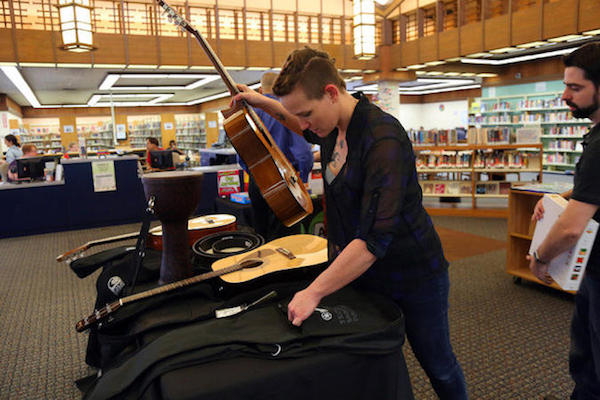
What are some of the best ways you’ve seen people building community around a Library of Things? Any tips for getting the word out?
We recommend starting by getting the word out via local blogs, visiting meetings of other community and business groups, and then moving on to more traditional media.
Running a crowdfunding campaign can also be a great way to help start or expand a tool or kitchen library into a Library of Things. Offering membership as a perk can both help you meet your funding goal and start building your membership before you open. Also, when members of the community contribute to starting the Library of Things, they become invested, both literally and figuratively, in its success.
If you are opening the first Library of Things in your area, getting media can be almost as easy as getting donations of items for your inventory. At myTurn, we even field calls from local TV and radio stations wanting to know if there is a Library of Things in their area because they have heard about them and would love to do a story about them. Most people love the idea of a Library of Things once they hear about it, so pitching online and traditional media is usually pretty easy.
Once you have people coming in the door—which is usually not difficult—building and connecting that community is important. We recommend adding classes and workshops as soon as you have the ability to do so. Bringing people together and helping ensure they have the skills to use the different types of things in the library is a great way to connect the community. Also encourage your members and class participants to tell their friends about the Library of Things.
I’d even recommend doing some fun events. For example, a games night where members and friends come and play some of the games at the Library of Things. The Denver Tool Library is even holding a concert series with local bands. It doesn’t get much better than that. These types of events build community and bring people into the space so they can see what it is all about.
##
The article was originally published in 2016. Follow @CatJohnson on Twitter.
Disclosure: MyTurn is an in-kind sponsor of Shareable offering technical support.
